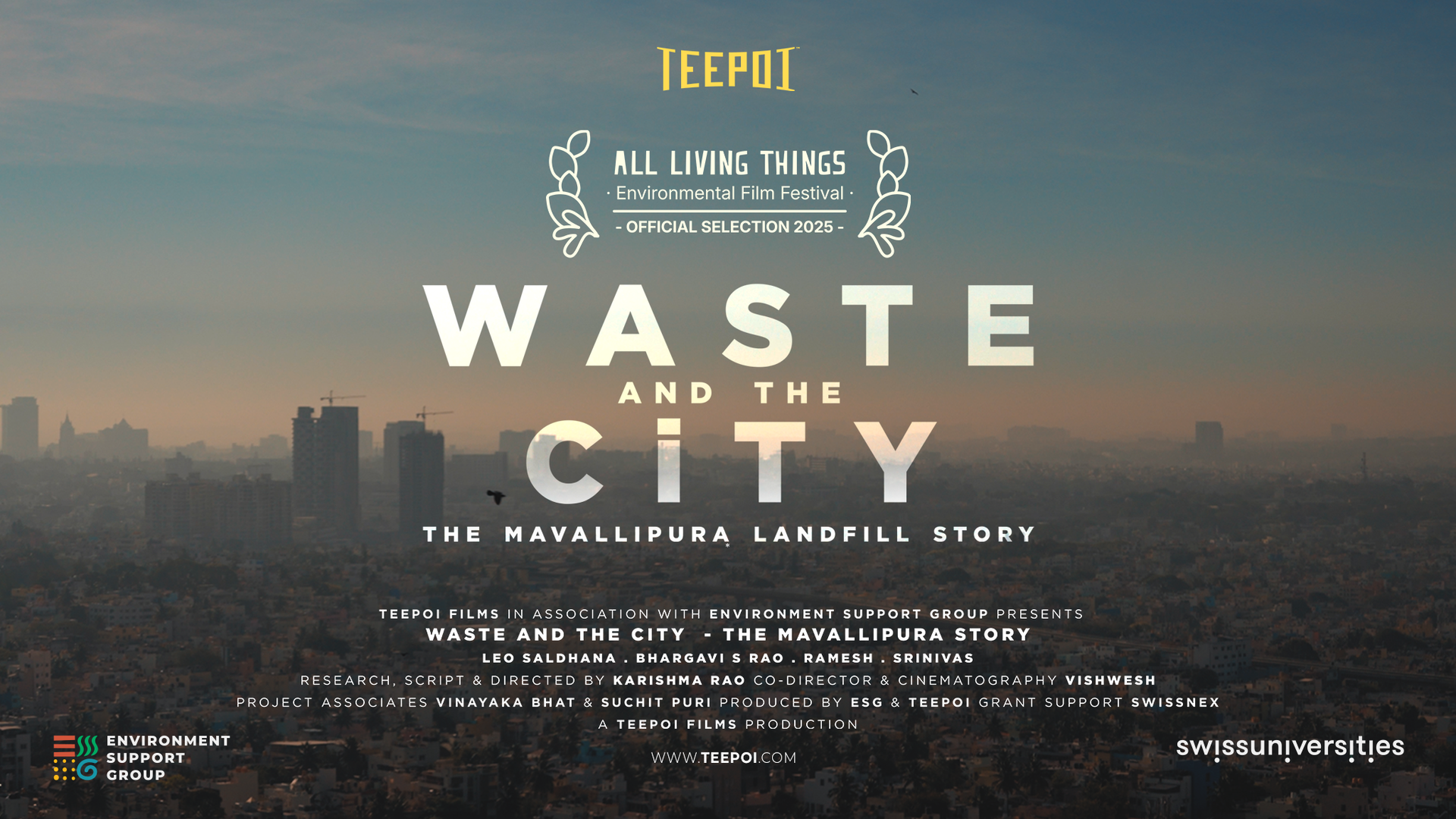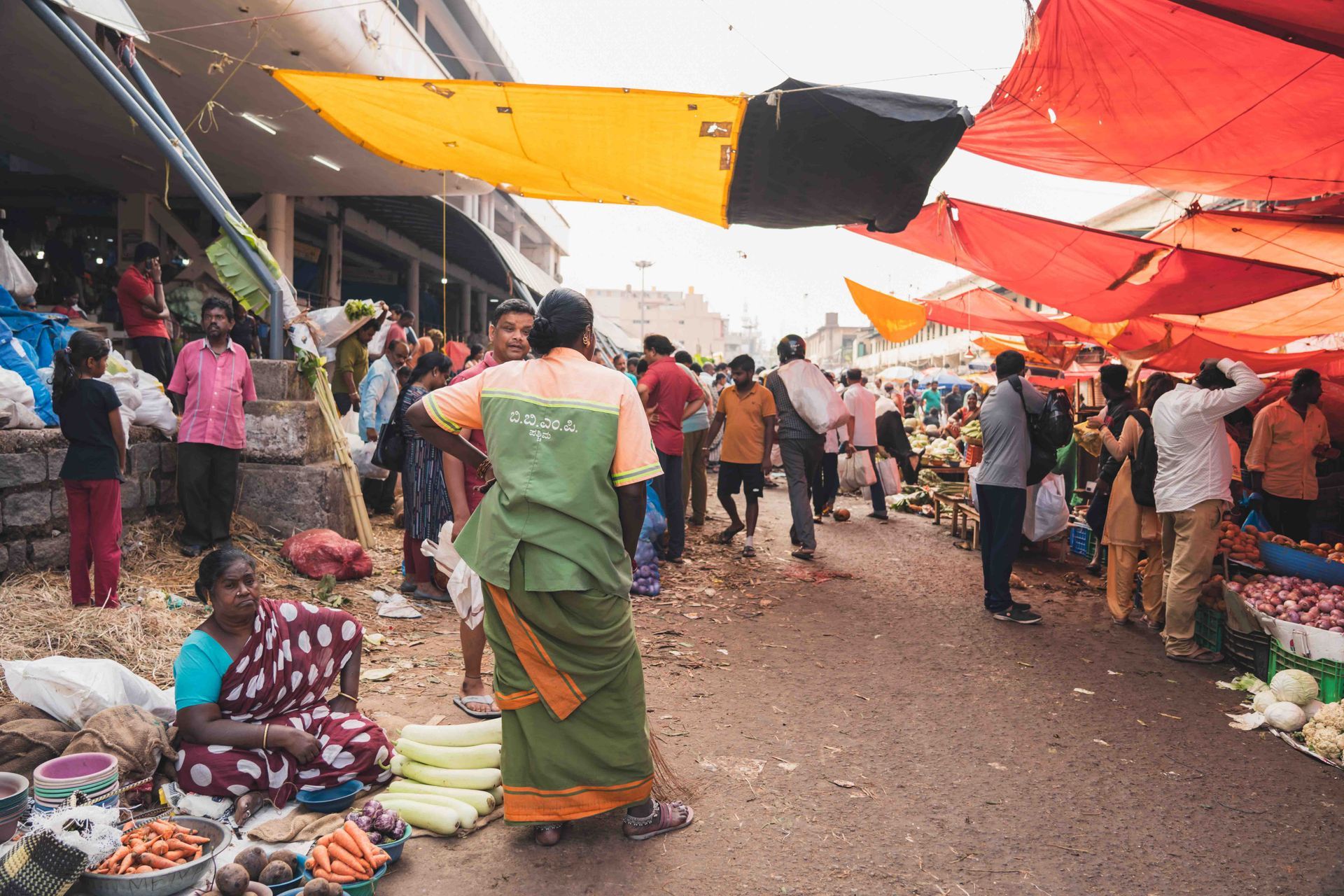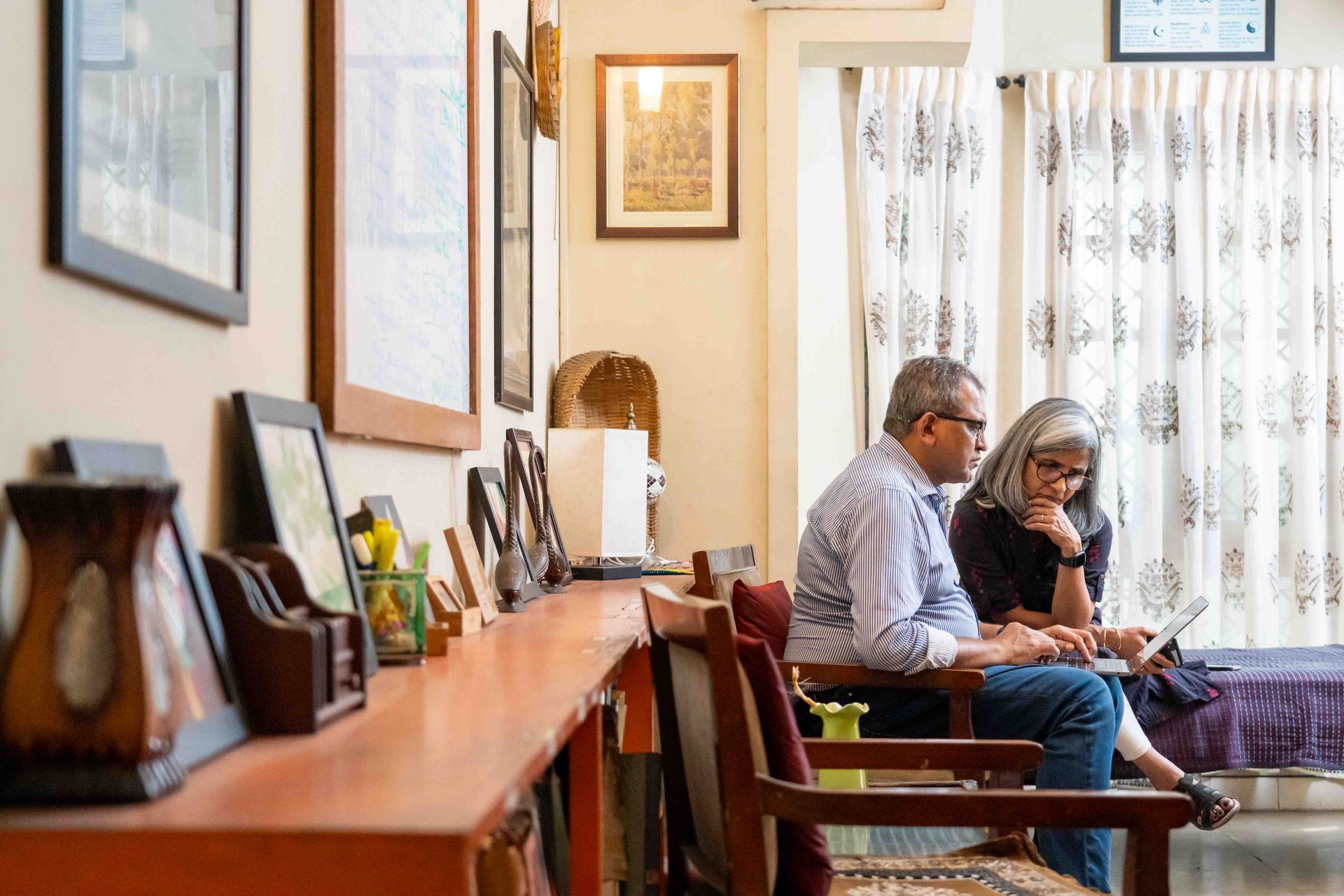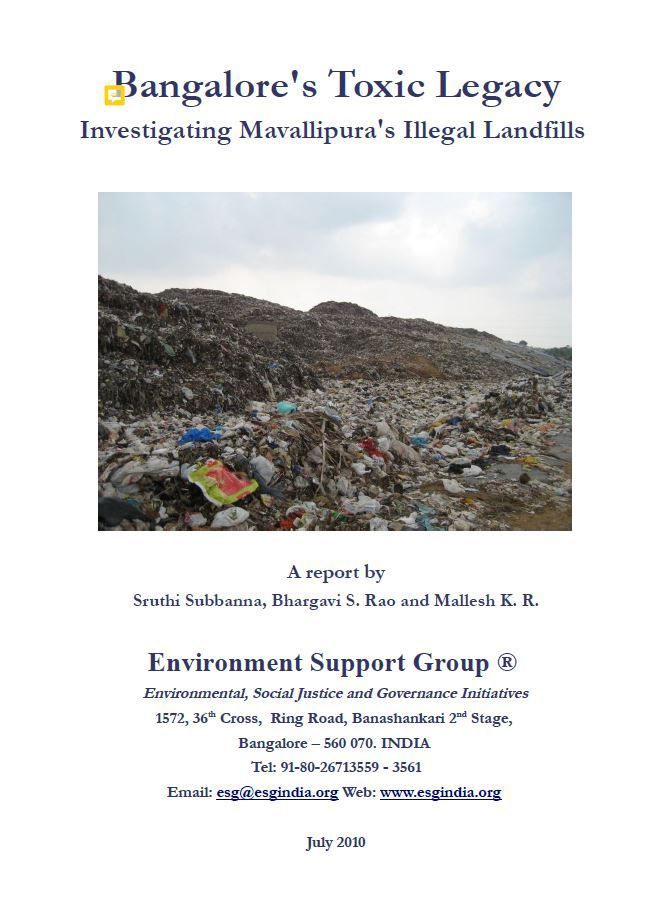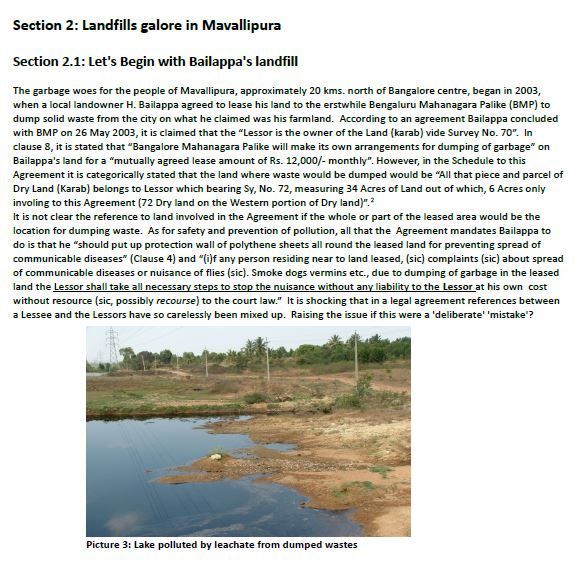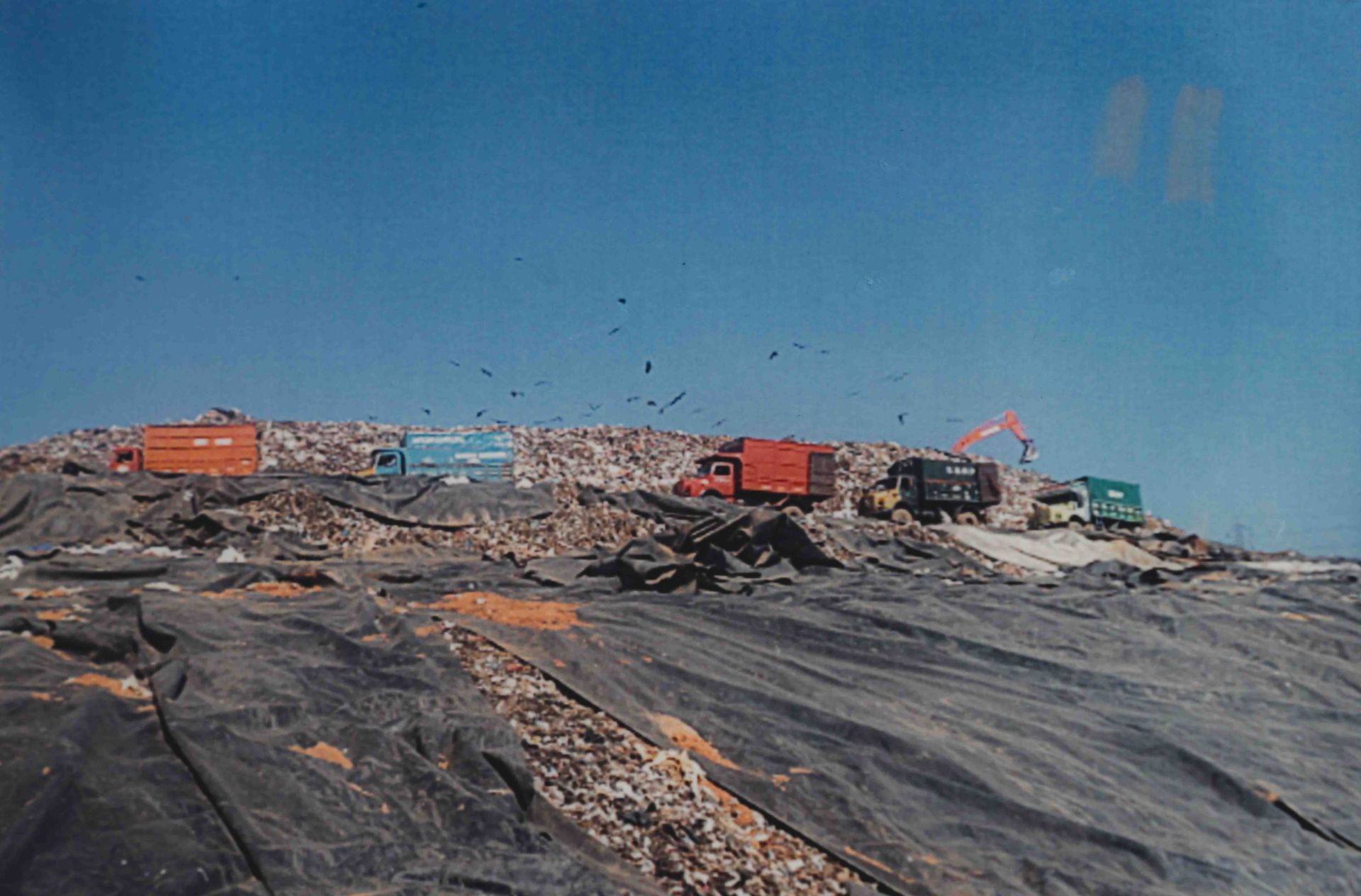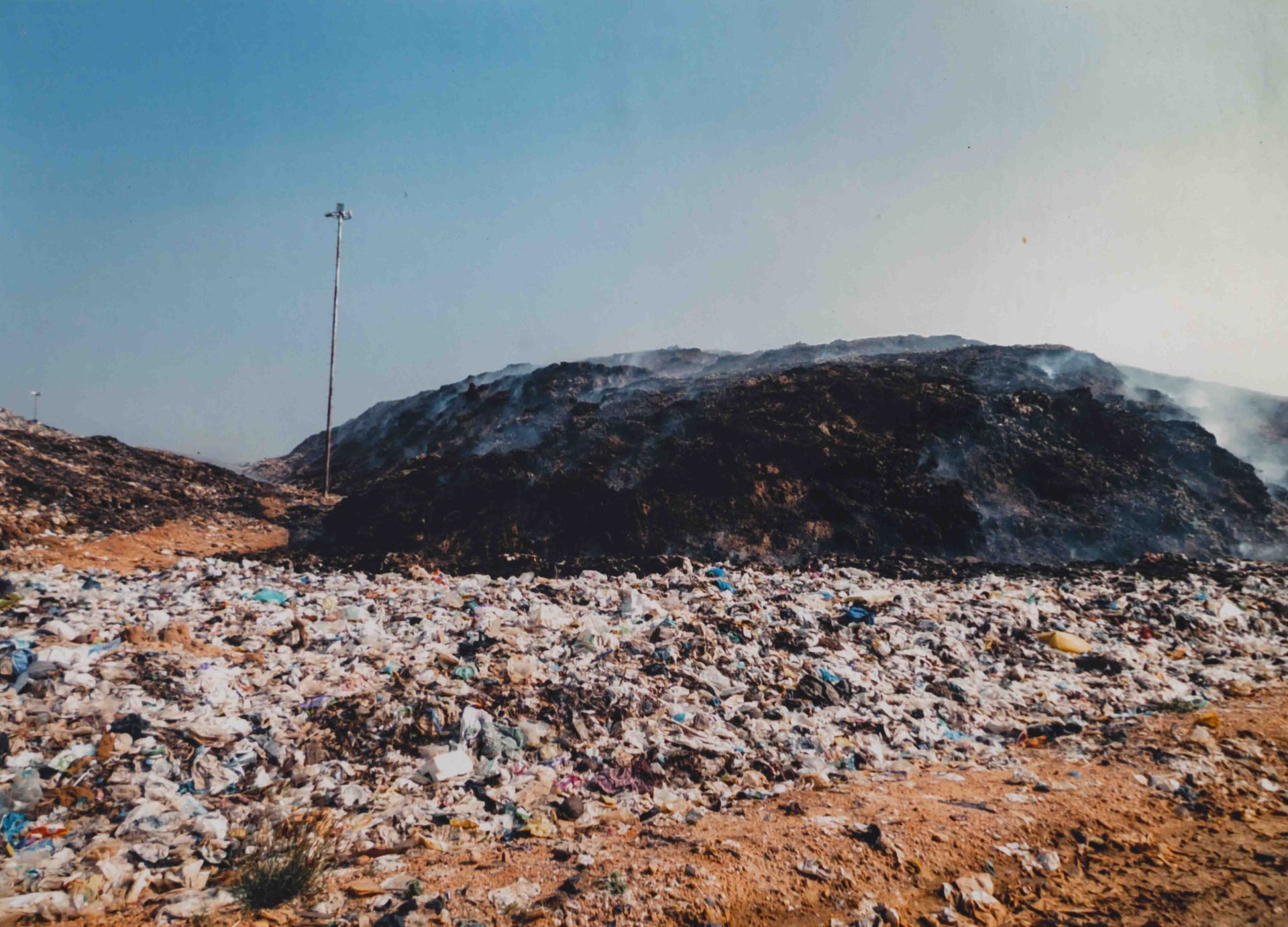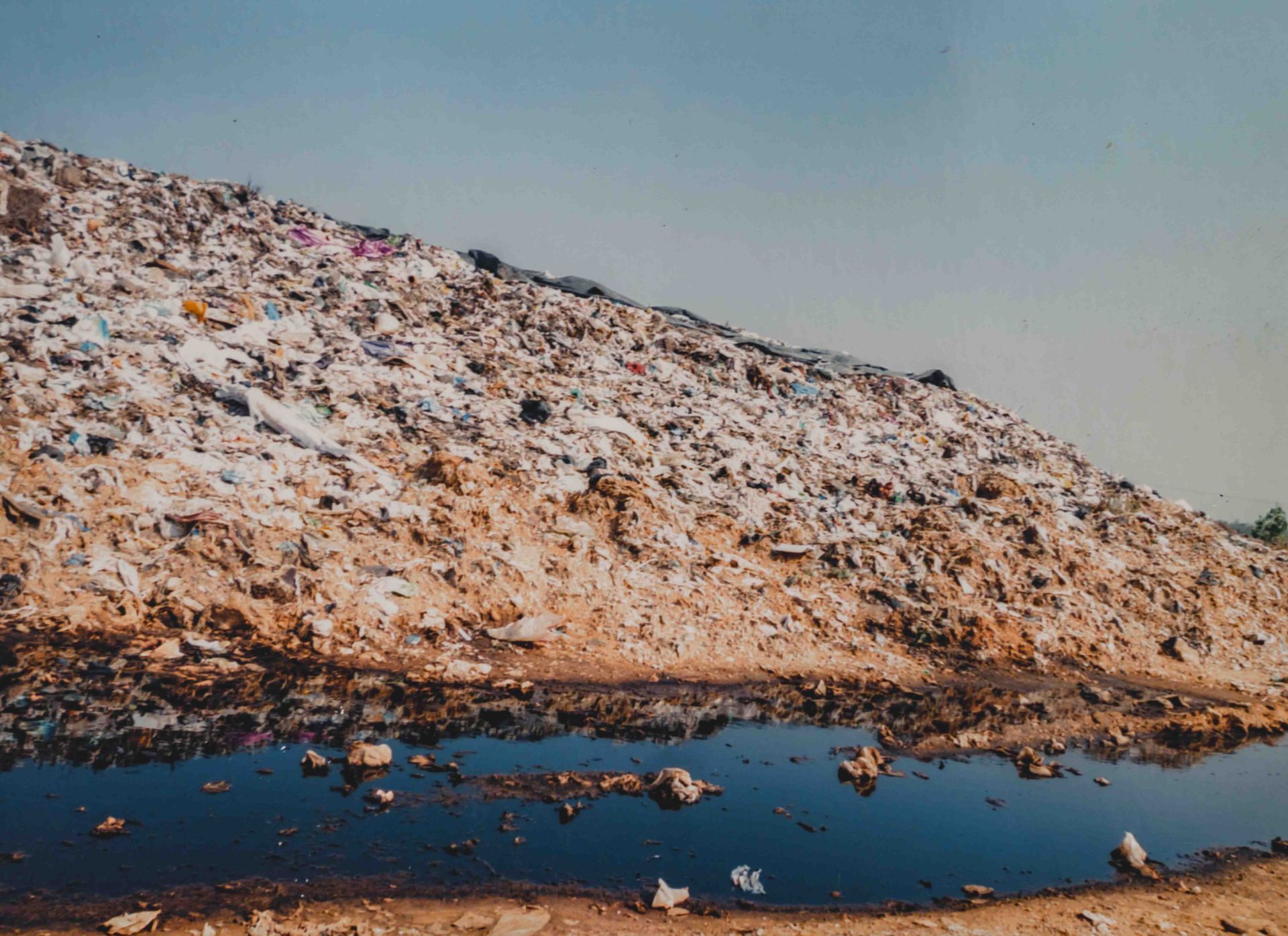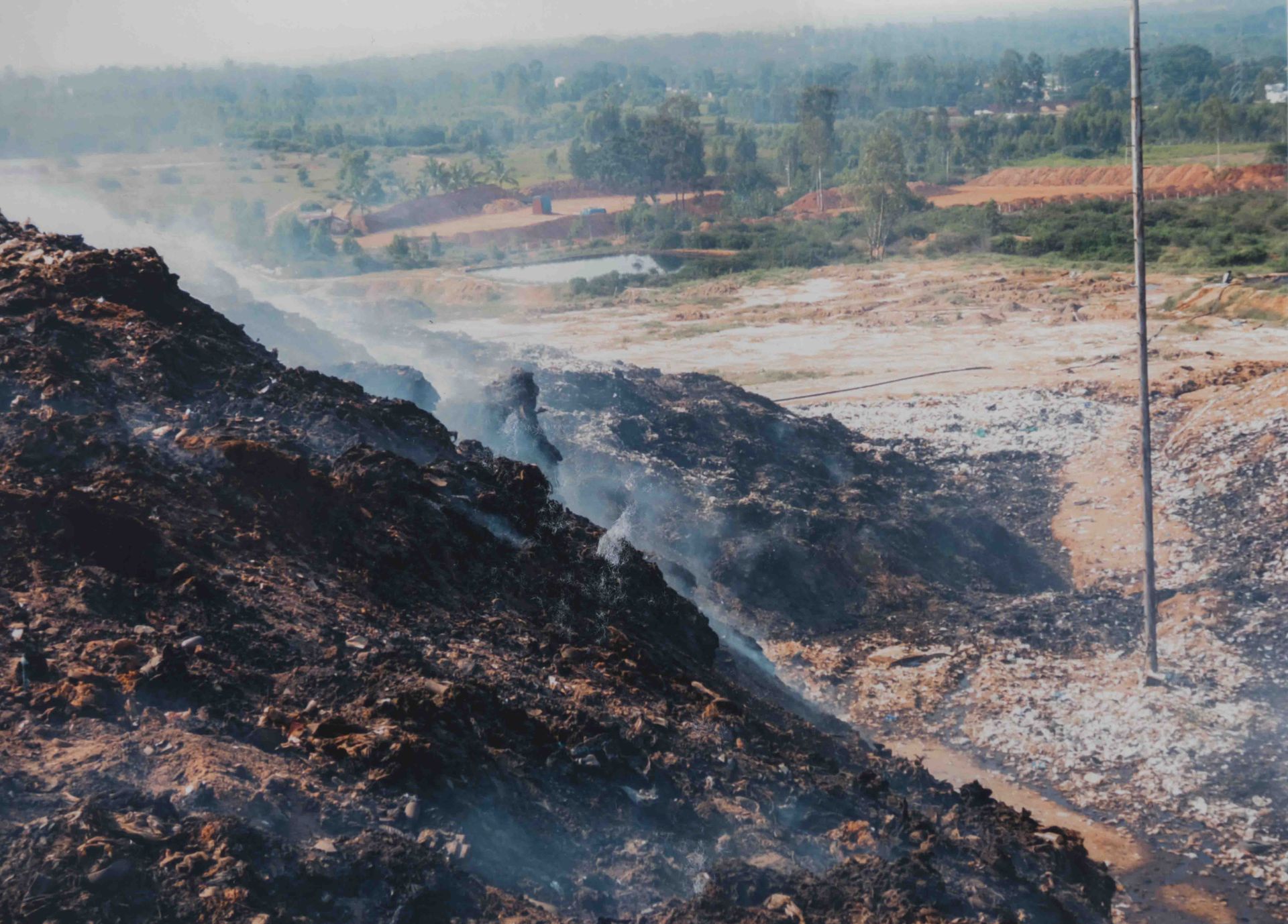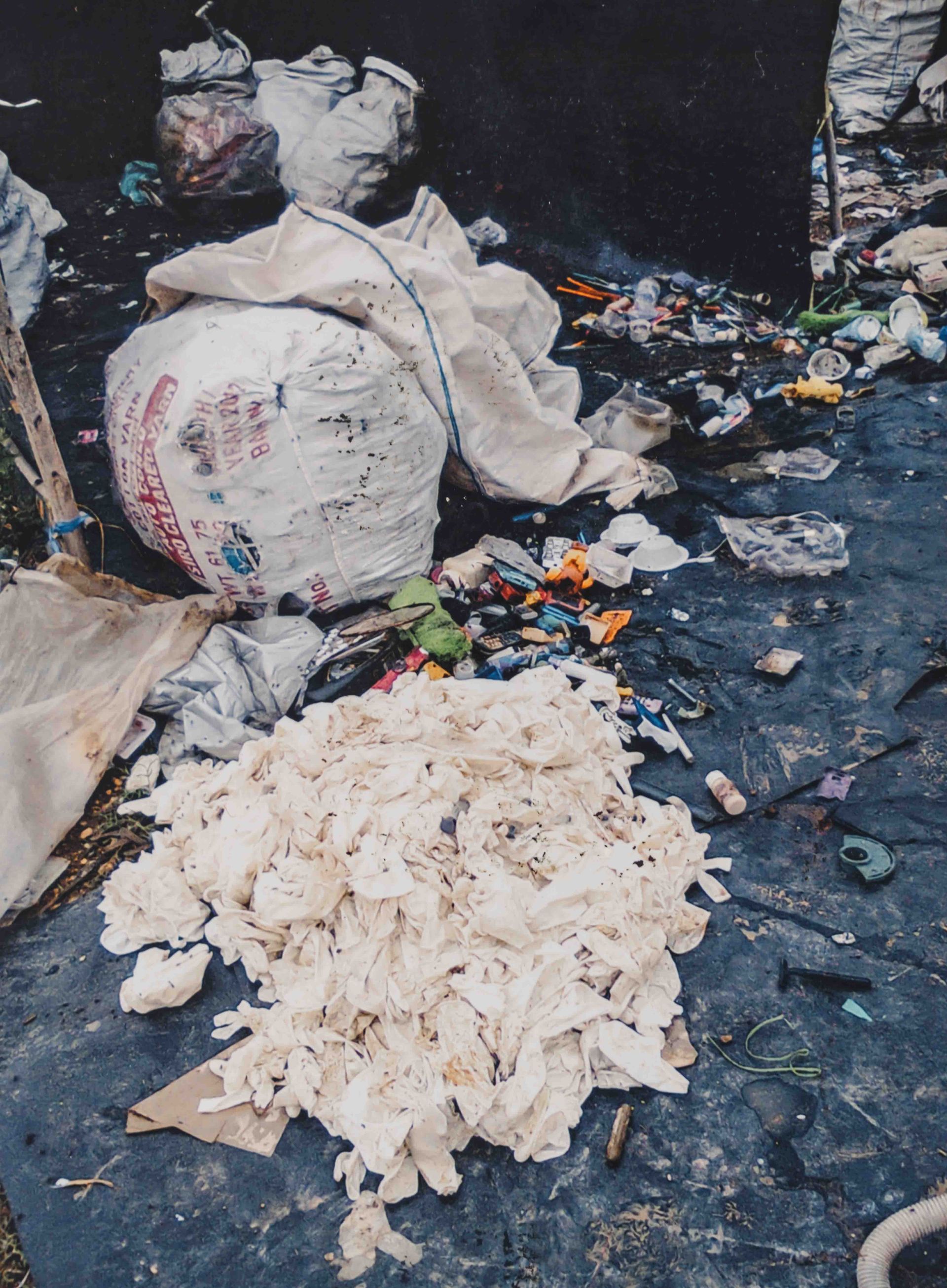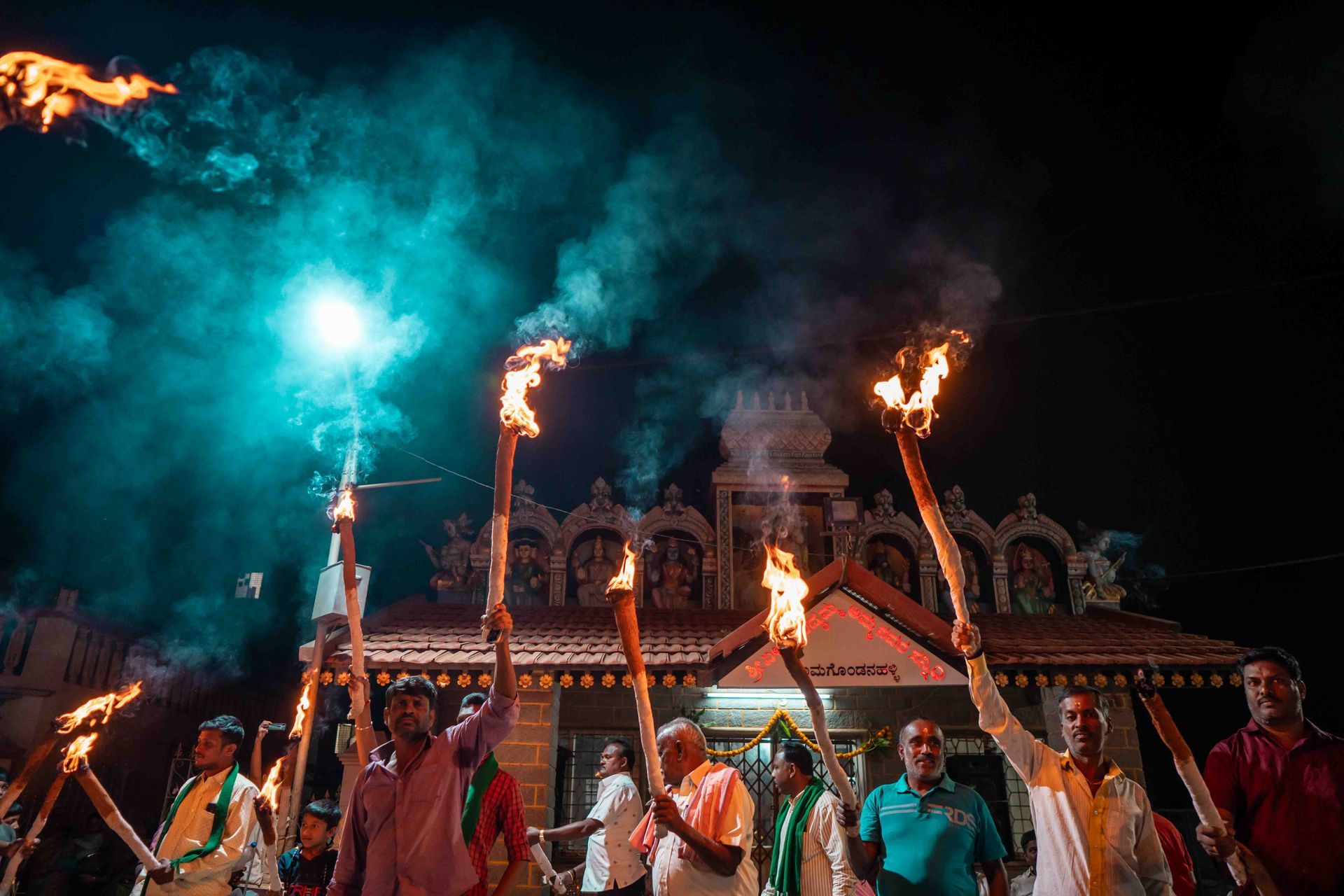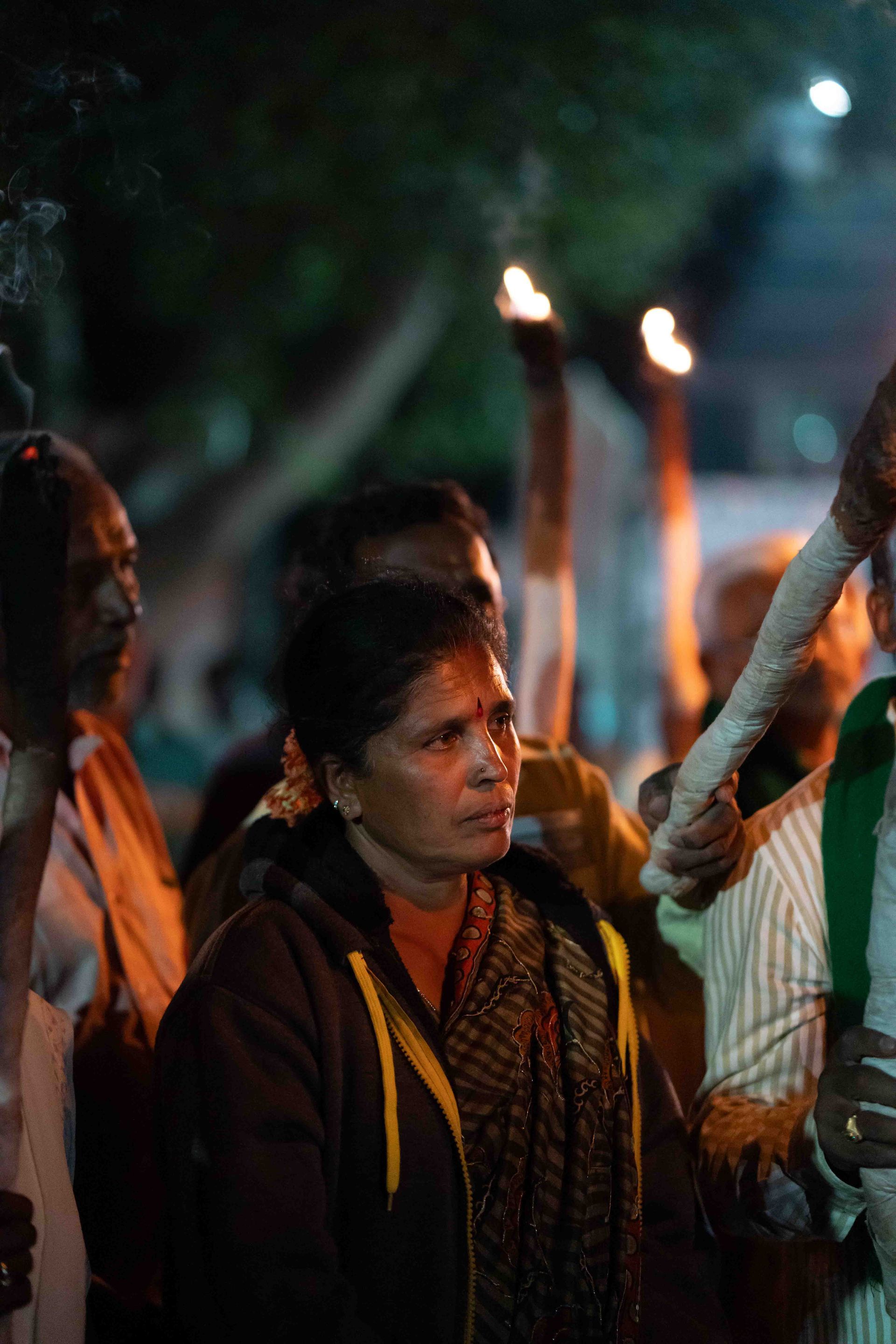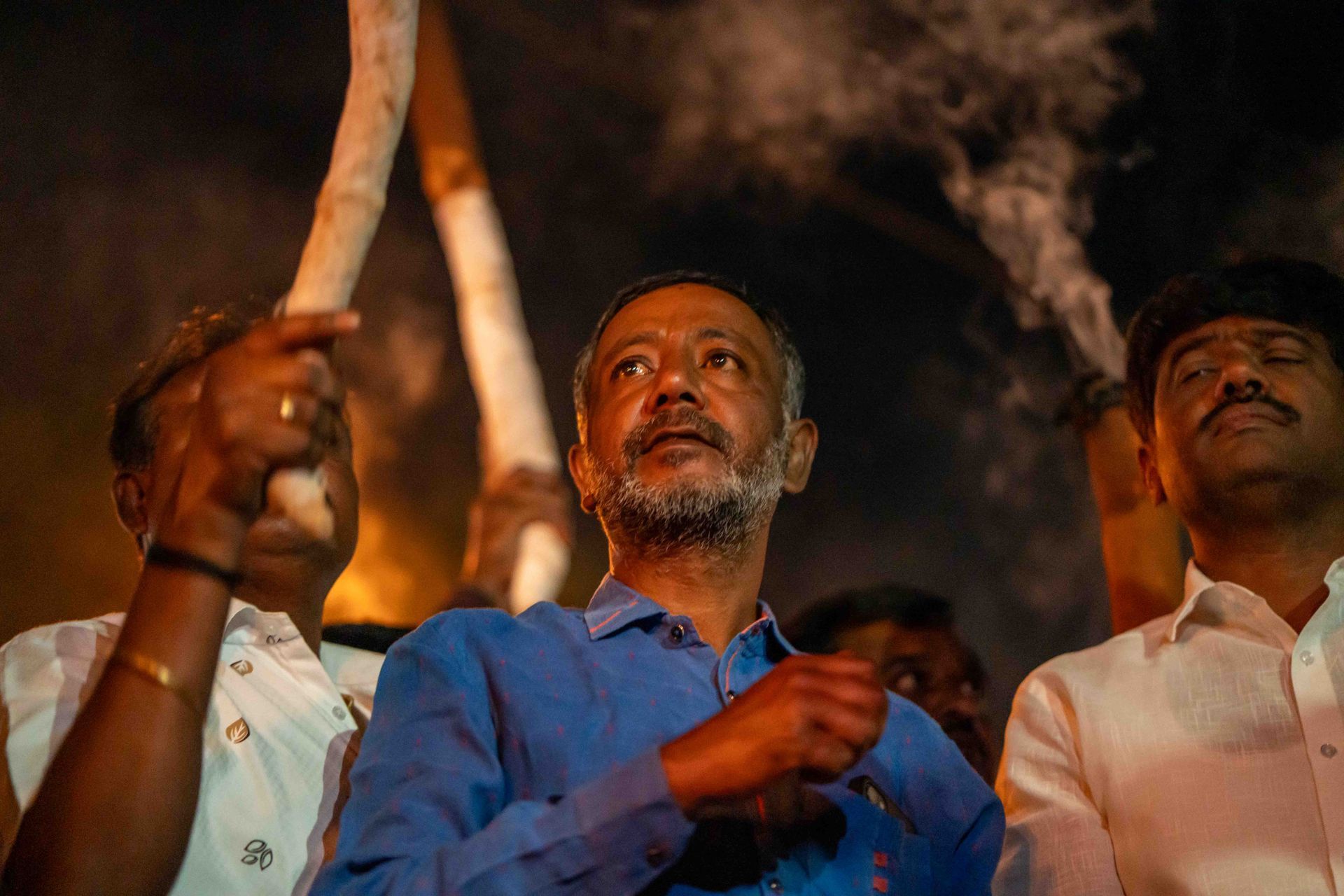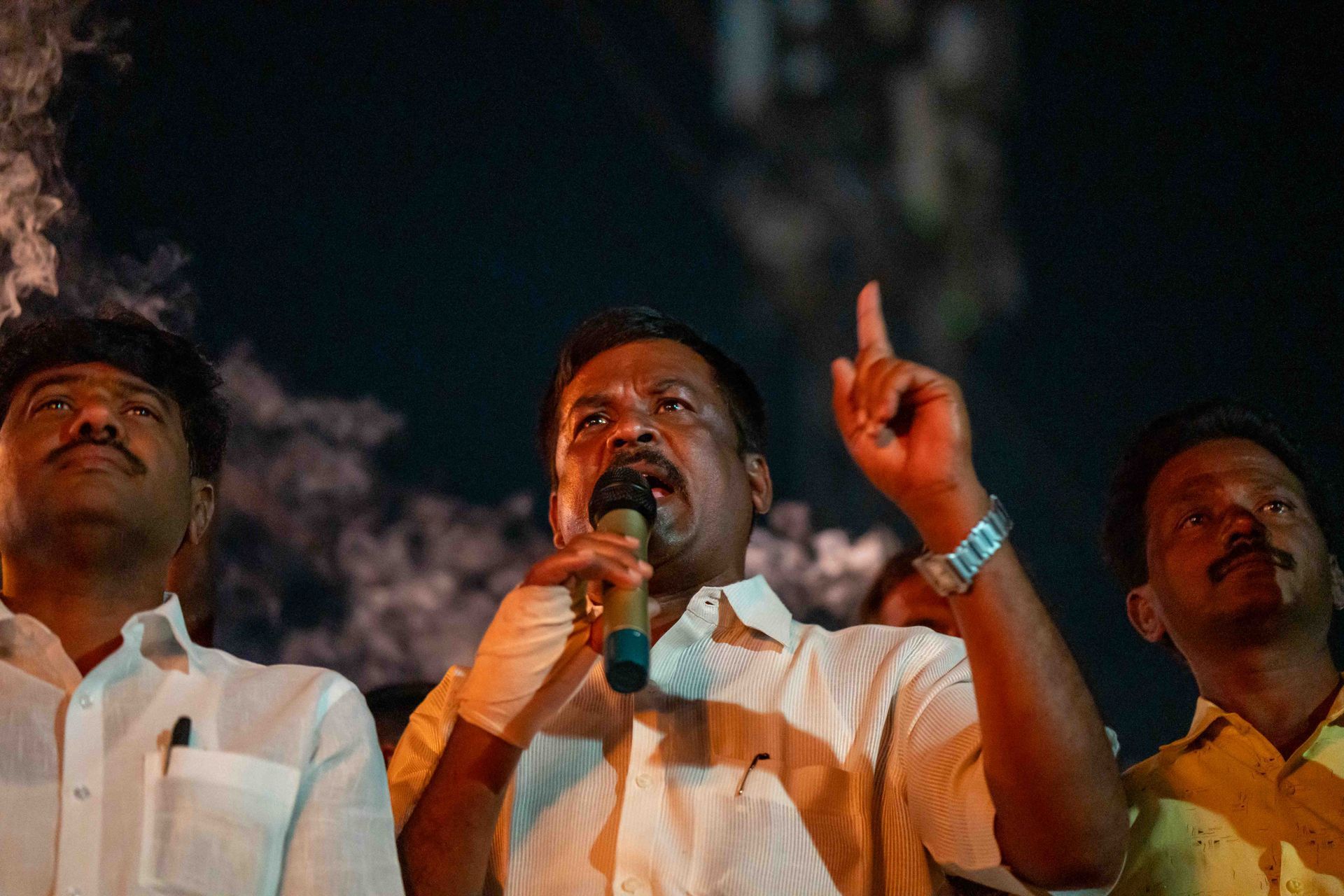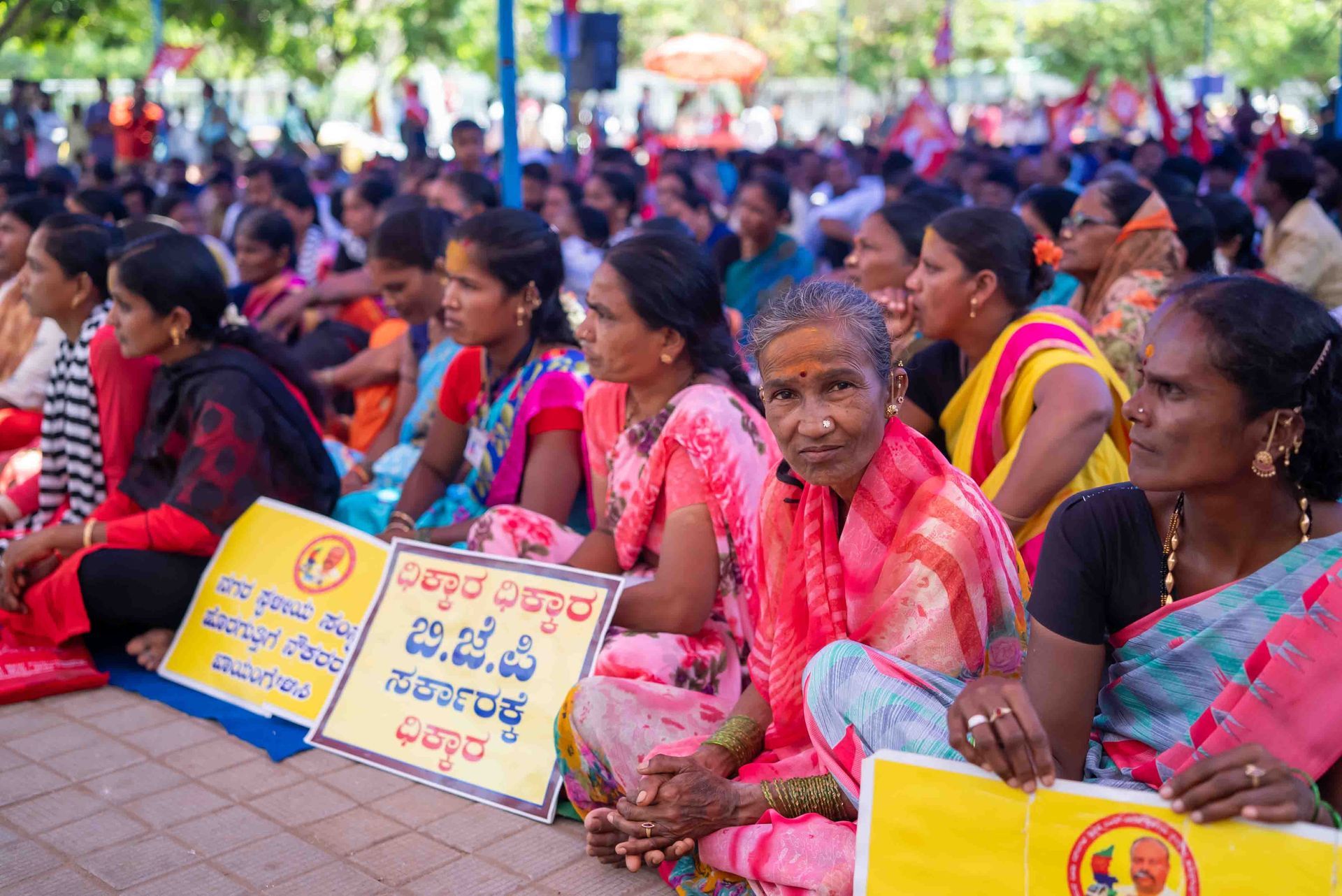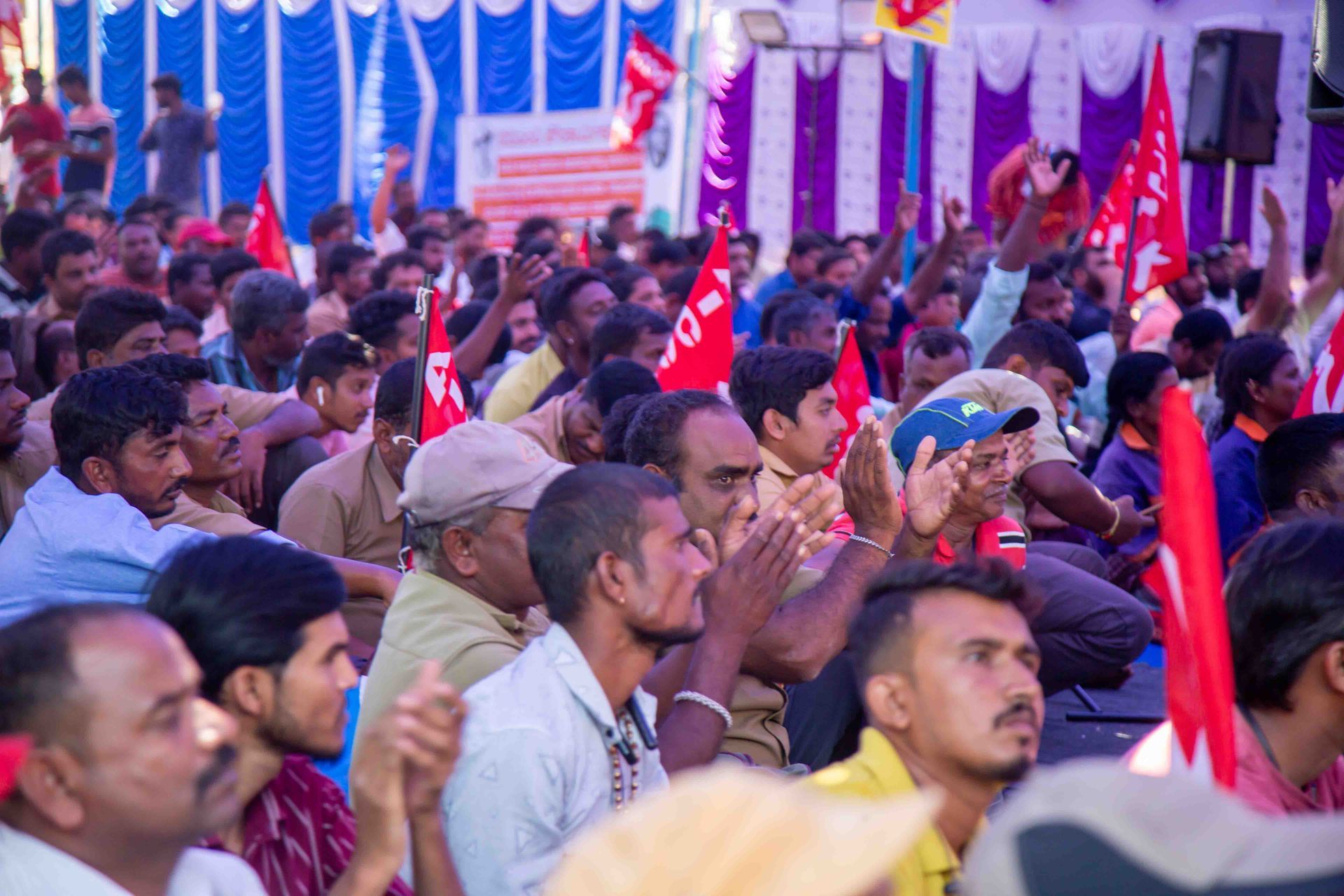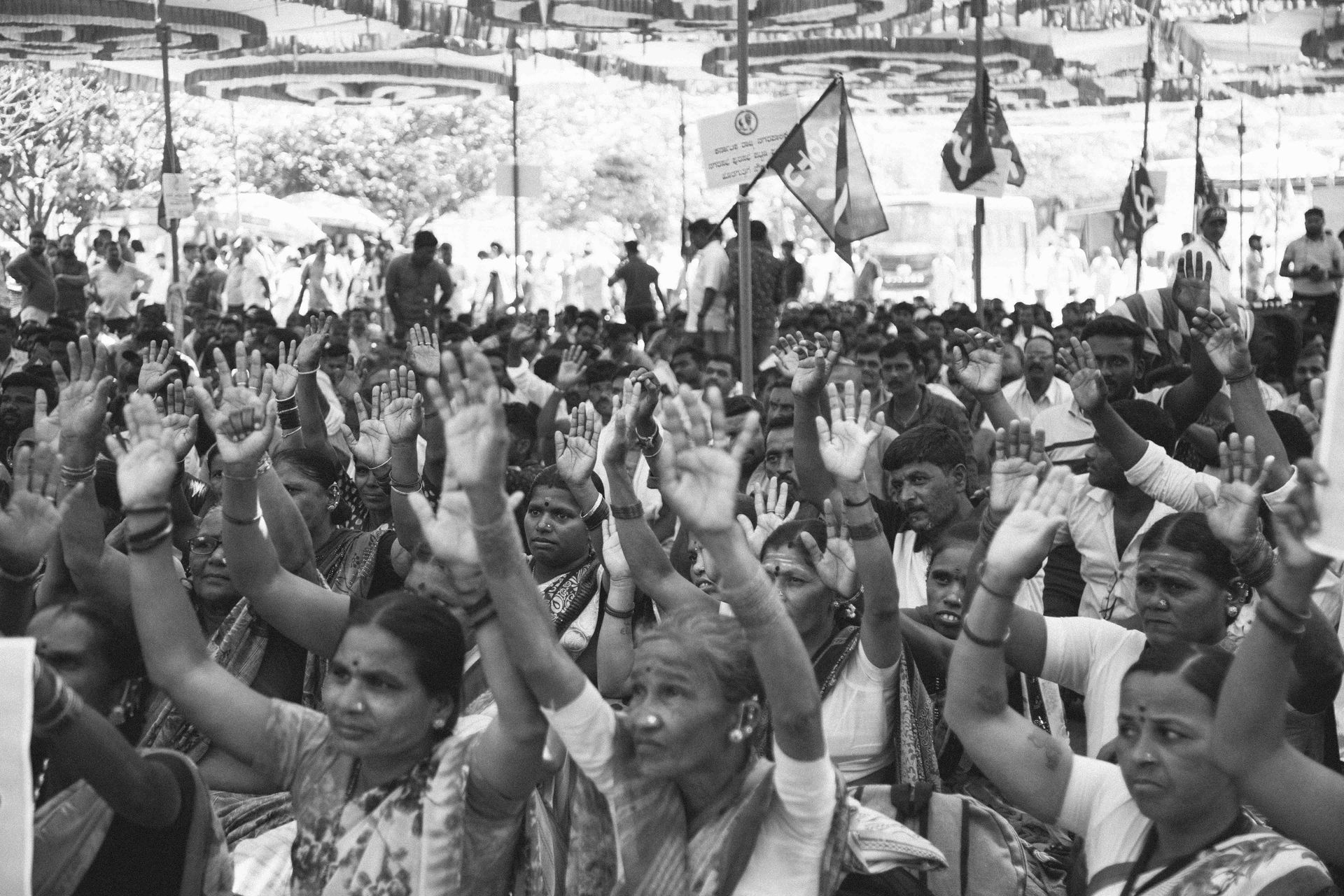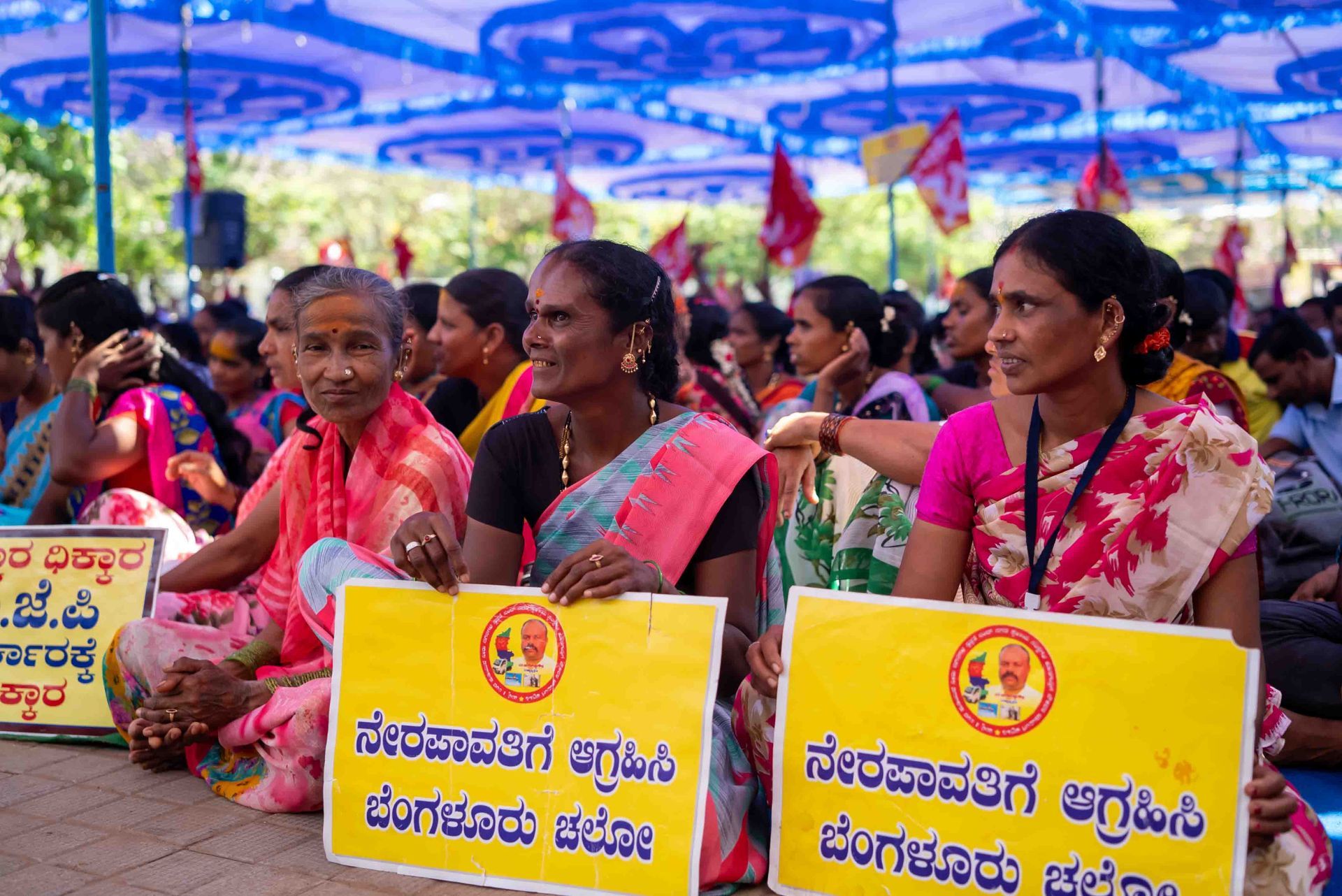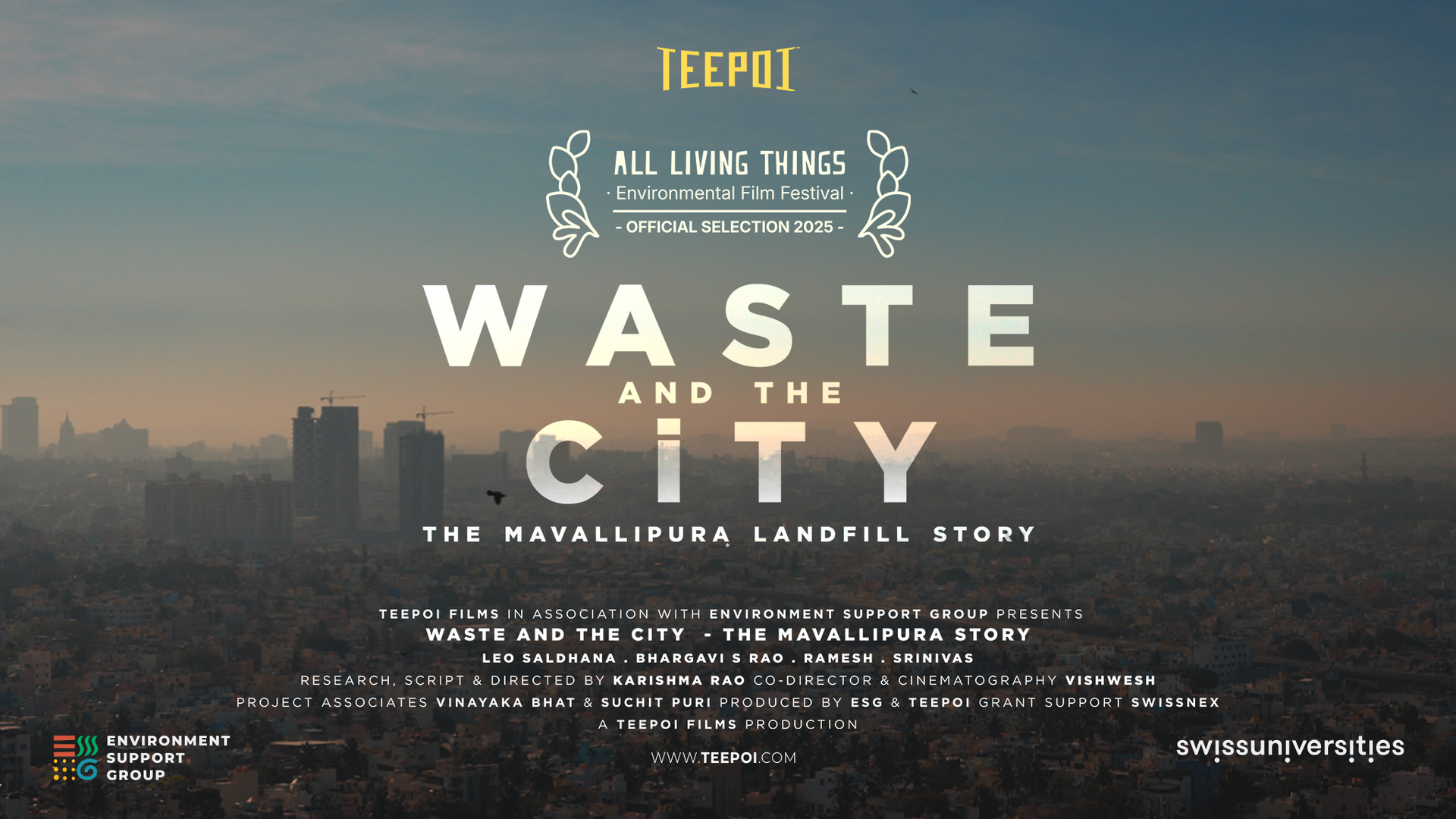Project Initiated
By Environment Support Group
Produced by
Teepoi Films
By Environment Support Group
W A S T E A N D T H E C I T Y
Waste and the City is a recap of the Mavallipura Landfill story - an instance of how research,
active citizenship and governance can converge to make a positive difference at scale.
Waste management is a mounting challenge for growing cities, with Bangalore being just one example of a metro city struggling on multiple fronts.
At the turn of the millenium, the Mavallipura landfill (among many others) made it to the headlines for sustained protests from its community members. Over 10 lakh tonnes of Bangalore’s waste got dumped at Mavalipura from 2003 until its closure in 2012.
Environment Support Group's decades-long documentation aided not only the termination of the landfill but moved the High Court to pass ordinances that organised much of the waste management efforts across the city at the time. Their study included a follow of I.P.D. Salappa’s report from 40 years before, about how little has changed for the Pourakarmika (sanitation workers) of Karnataka, who continue to face discrimination and exploitation.
For a city known to be a frontrunner of science and technology, there still looms an ever pertinent question of how much has really changed for the better?
This documentary was initiated by Environment Support Group through a grant supported by Swissnex, and produced by Teepoi.
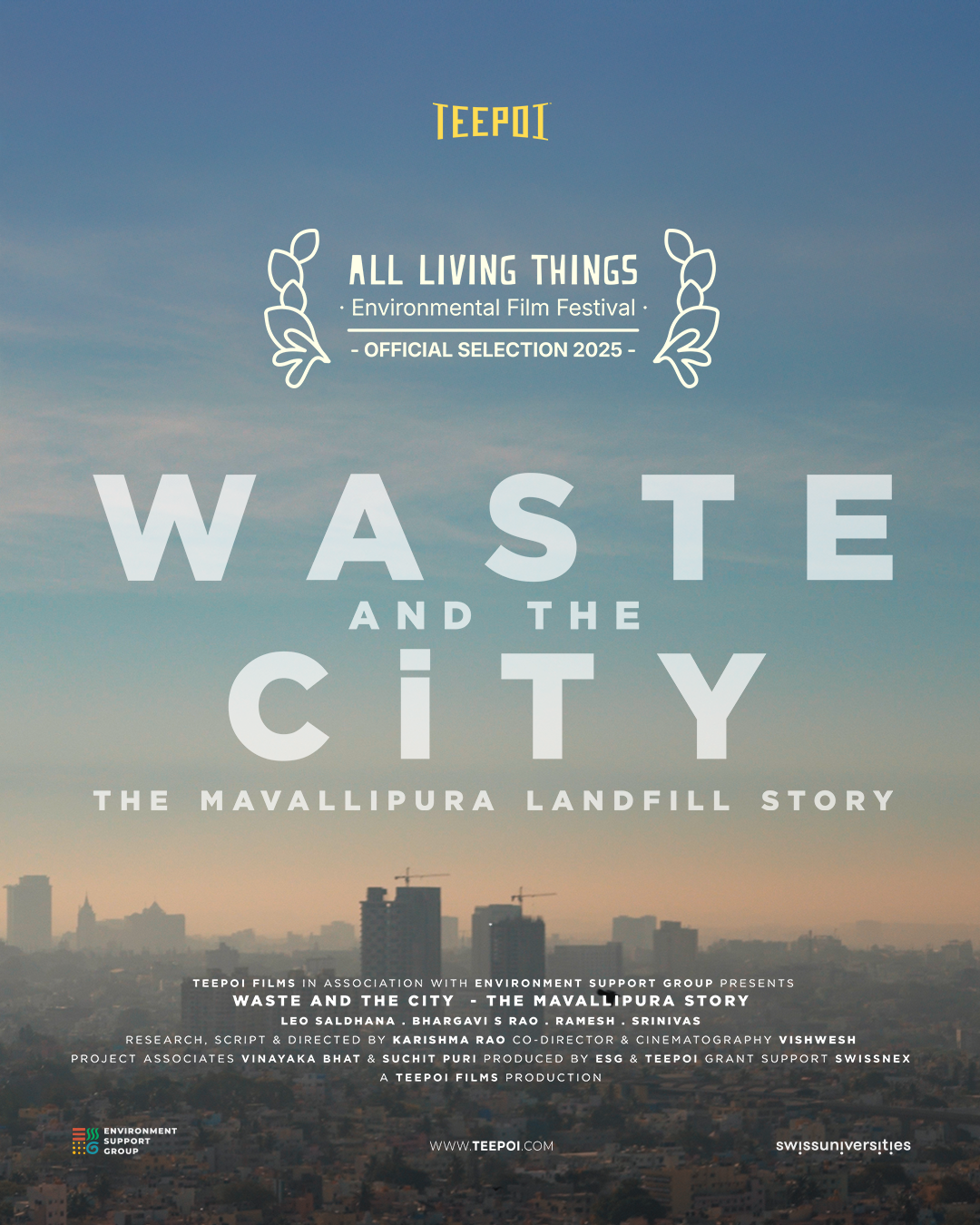
Category
Short Documentary Film
Duration
28 Mins 41 Secs
Year
2025
Project Initiated
By Environment Support Group
Produced by
Teepoi Films
W A S T E A N D T H E C I T Y
Waste and the City is a recap of the Mavallipura Landfill story - an instance of how research,
active citizenship and governance can converge to make a positive difference at scale.
Waste management is a mounting challenge for growing cities, with Bangalore being just one example of a metro city struggling on multiple fronts.
At the turn of the millenium, the Mavallipura landfill (among many others) made it to the headlines for sustained protests from its community members. Over 10 lakh tonnes of Bangalore’s waste got dumped at Mavalipura from 2003 until its closure in 2012.
Environment Support Group's decades-long documentation aided not only the termination of the landfill but moved the High Court to pass ordinances that organised much of the waste management efforts across the city at the time. Their study included a follow of I.P.D. Salappa’s report from 40 years before, about how little has changed for the Pourakarmika (sanitation workers) of Karnataka, who continue to face discrimination and exploitation.
For a city known to be a frontrunner of science and technology, there still looms an ever pertinent question of how much has really changed for the better?
This documentary was initiated by Environment Support Group through a grant supported by Swissnex, and produced by Teepoi.

Category
Short Documentary Film
Duration
28 Mins 41 Secs
Year
2025
This is paragraph text. Click it or hit the Manage Text button to change the font, color, size, format, and more. To set up site-wide paragraph and title styles, go to Site Theme.
The journey of solid waste management in the state of Karnataka entails many challenges existing in the sanitation sector, including failure in delivery by the government and parastatal agencies, status of the pourakarmika or safai karmachari from then to now, etc. The story is one of failure of the system towards not just its citizens but generations of communities that have toiled by carrying out a crucial service of keeping the city disease free and clean on a day to day basis.
Marginalised communities and dalits are usually the designated sanitation workers in any Indian city - be it street sweepers, sewer and manhole cleaners, community and public toilet cleaners, septic tank cleaners, faecal sludge movers, etc. Their job is intergenerational and systemically challenging to move away from as it is an assured source of income for the downtrodden, who have few options to employment in other sectors due to the social stigma that surrounds them.
Under the guidance of the then CM Shri Devaraj URS, MLA Shri IDP Salappa headed a committee (The Karnataka Sweepers and Scavengers Living and Working Conditions Improvement Committee) that physically traversed the state of Karnataka between 1974 and 1976 to document the condition of sanitation workers, and came up with a comprehensive report (the Salappa Committee Report) with tangible recommendations to alleviate the status of the workers - covering aspects of minimum wage, benefits, safety measures, work hours, etc. amongst others. Close to half a century since the report was published, very little has been done to either implement the recommendations or uplift the sanitation workers.
Under the guidance of the then CM Shri Devaraj URS, MLA Shri IDP Salappa headed a committee (The Karnataka Sweepers and Scavengers Living and Working Conditions Improvement Committee) that physically traversed the state of Karnataka between 1974 and 1976 to document the condition of sanitation workers, and came up with a comprehensive report (the Salappa Committee Report) with tangible recommendations to alleviate the status of the workers - covering aspects of minimum wage, benefits, safety measures, work hours, etc. amongst others. Close to half a century since the report was published, very little has been done to either implement the recommendations or uplift the sanitation workers.
Environmental Support Group (ESG) is an independent organisation that was started in 1996 with solid waste management as a core work area under the Environmental, Social Justice and Governance oriented initiatives that drove the organisation to take shape. ESG’s decades-long documentation aided not only the termination of the landfill but moved the High Court to pass ordinances that organised much of the waste management efforts across the city at the time. Their study included a follow of I.P.D. Salappa’s report from 40 years before, about how little has changed for the Pourakarmika (sanitation workers) of Karnataka, who continue to face discrimination and exploitation.
Environmental Support Group (ESG) is an independent organisation that was started in 1996 with solid waste management as a core work area under the Environmental, Social Justice and Governance oriented initiatives that drove the organisation to take shape. ESG’s decades-long documentation aided not only the termination of the landfill but moved the High Court to pass ordinances that organised much of the waste management efforts across the city at the time. Their study included a follow of I.P.D. Salappa’s report from 40 years before, about how little has changed for the Pourakarmika (sanitation workers) of Karnataka, who continue to face discrimination and exploitation.
Notes from ESG’s Report “Bangalore’s Toxic Legacy” produced in 2010
Unplanned urbanisation coupled with unprecedented increase in consumerism are causing extensive impacts on human health and the environment. As urban residents become more consumerist and cities become a locus of intense resource consumption, the capacity to generate waste is maximised. The weak impetus to minimise waste generation and poor management of the waste generated is resulting in a huge public health and environmental problem.
Notes from ESG’s Report “Bangalore’s Toxic Legacy” produced in 2010
Unplanned urbanisation coupled with unprecedented increase in consumerism are causing extensive impacts on human health and the environment. As urban residents become more consumerist and cities become a locus of intense resource consumption, the capacity to generate waste is maximised. The weak impetus to minimise waste generation and poor management of the waste generated is resulting in a huge public health and environmental problem.
The neglect of such questions result in complex problems that are exacerbated by poor land use planning and waste management practices. There is little or no emphasis on community level solid waste management and this callousness has dire consequences for communities who become victims of large and poorly managed landfills. Forced to coexist with mountains of festering waste dumped in their backyards, these unfortunate people suffer unbearable stench, are forced to drink toxic water and end up with severe debilitating effects on their health and livelihoods.
Over 3000 tonnes of waste is generated in Bangalore every day, a good proportion is unhealthily dumped in the periurban areas of the city, with farmlands and wetlands becoming prime targets. Oftentimes forest areas are also happy dumping grounds for waste disposal. An out of sight out of mind attitude pervades the administration and regulatory approach to solid waste management.
A case in point is what is claimed to be a designated municipal solid waste management landfill at Mavallipura, a village north of Bangalore near Yelahanka. Waste has been dumped here since 2003 in what was claimed to be farmer Bailappa's lands. A consistent process by local people succeeded in stopping this massive illegal waste dump only for a similar landfill to recur abutting grazing pastures extending over 100 acres claimed to be designated scientific landfill managed by M/s Ramky Infrastructure Ltd.
The Mavallipura landfills are a clear indicator of the callous disregard that BBMP has for public health and environmental laws and standards of India. This situation is also an alarming indicator of the appalling dismissal of the Fundamental Right of the communities of Mavallipura and surrounding villages to live a life of dignity, and in a clean environment.
People are dying in Mavallipura today. Despite many falling sick with increasing regularity, there simply has not been any comprehensive effort on the part of BBMP or the health authorities to attend to this health crisis. It is deeply worrying that many are reporting incurable diseases like cancer, kidney failure, etc. which could well be a result of the high toxicity in the ambient environment.
This kind of situation arises due to the acute disregard to a simple and effective solution to the problem: segregating waste at source, composting organic waste locally, recovering recyclables locally to the maximum possible extent, and only transporting useless and hazardous material to landfills. For this to happen, everyone who generates waste must own up the responsibility for the adverse impacts we are causing on the people of Mavallipura, and similar communities around Bangalore.
Timeline of events
- Waste Dumping Begins26 May 2003
Bangalore’s waste starts being dumped in what was claimed to be farmer Bailappa's lands post agreement between Bailappa and BMP.
- Declared as eco sensitive zone12 January 2004
Order of the Department of Ecology and Environment declares this area as an ecologically sensitive zone as it forms the watershed of the Arkavathy and Kumudavati rivers.
- Impact Assessment ReportJanuary-March 2004
Environment Impact Assessment Report for the landfill was prepared by M/s Ramky Testing and Consultancy Services erroneously claiming that there are no ecologically sensitive zones within 10 kms. radius
- Setup of Scientific Landfill11 August 2004
A Concession Agreement was concluded between BMP and Ramky Infrastructure Ltd. (RIL) to set up a scientific landfill on the basis of Build-Operate-Transfer (BOT) scheme at Survey No. 8 of Mavallipura village over 100 acres to manage a contracted quantity of 600 tonnes of mixed solid waste per day.
- Civil Aviation refuses NOC14 August 2004
Both defense and civil aviation authorities have (after refusing to grant a No Objection Certificate to Mavallipura landfill in the letter dated 14th August 2004) raised alarm at the heightened risk of air crashes that are likely given the high density of scavenging bird populations such poorly managed dumping grounds attract.
- Scientific Landfill18 August 2004
The Board had authorised the setting up of scientific landfills by BMP at two locations in Bangalore – Mavallipura and Kannahalli.
- Letter to Commissioner of BBMP7th September 2004
Shri. Vittala Murthy, (Secretary to the Karnataka Dept. of Ecology and Environment) in his letter to the Commissioner of BMP stated that “as per Municipal Solid Waste (Management and Handling) Rules, 2000 dated 25.09.2000, the municipal solid waste shall be disposed of in a scientific manner in identified landfill sites only after obtaining authorisation from KSPCB.
- Dumping on a daily basis2003-2006
On a daily basis, 150 to 200 trucks dumped their waste in this land for rent of Rs.12,000/-
- Health Camp ReportsJune 2005
RLHT health camp for local communities reported that a “majority of patients (both children and adults alike) suffered from allergic rhinitis, allergic dermatitis, repeated infections, diarrhoea, sleeplessness, cough and upper respiratory tract infections.
- ComplaintOctober 2005
DSS initiated a formal complaint to the Board.
- Water Contamination22nd October 2005
Bailappa and his family in collusion with BMP officials released thousands of litres of leachates that had accumulated in the dump into the downstream grazing pasture in Survey No. 8. This toxic water soon found its way into wells, streams and lakes, and consequently all drinking water sources were contaminated.
- Encroachment over forest land2005
Landfill in Bailappa’s land closed after discovery of farmer’s encroachment over forest land.
- Legal Action Taken18 February 2006
Karnataka State Pollution Control Board initiated Criminal proceedings against Bailappa and his son by filing a Criminal Complaint before the Metropolitan Magistrate in Bangalore
- Cover Up2006
To cover up the evidence of what lay beneath, the mountains of garbage that had accumulated over the years were burnt off over several days, and tonnes of soil was imported to cover up the toxic mess within.
- Without a Consent29 January 2007
Ramky landfill was made commercially operational without a consent for operation from KSPCB.
- Protest7 October 2009
Riot ensued in Mavallipura when local villagers realised that hundreds of gallons of toxic discharge had been facilitated out of the landfill by digging trenches – so the overflow would not accumulate within the REEL facility, but instead flow downstream into the village.
- Promises9 October 2009
Meeting with the Commissioner, then Shri. Bharat Lal Meena, IAS, who promised comprehensive clean-up, pollution and cattle survey, groundwater contamination, health camps and that fresh borewells would be dug to provide clean drinking water.
- ESG Research beginsNovember 2005 to September 2017
ESG undertook comprehensive analysis of the quality of water in various upstream and downstream locations of the Mavallipura landfills to establish the pollution impact of the illegal landfill developed by Bailappa for BMP between 2003-2006.
- Two DeathsJuly 2010
Two deaths in Mavallipura due to cancer and dengue: alarming indicators of the deteriorating health status of local communities.
- Bangalore’s Toxic LegacyJanuary 1st, 2020
ESG publishes Bangalore’s Toxic Legacy - Investigating Mavallipura's Illegal Landfills.
- Water quality degraded2012
Sufficient information available to suggest that the quality of water in Mavallipura and downstream villages has degraded rapidly.
- Landfill ShutdownJuly 2012
Ramky landfill closed after action initiated by KSPCM after several protests and demonstrations by the community.
- Bangalore’s Toxic Legacy IntensifiesFebruary 2018
ESG publishes Bangalore’s Toxic Legacy Intensifies - Status of Landfills, Waste Processing Sites and Dumping grounds, and working conditions of Pourakarmikas
Timeline of events
- Waste Dumping Begins26 May 2003
Bangalore’s waste starts being dumped in what was claimed to be farmer Bailappa's lands post agreement between Bailappa and BMP.
- Declared as eco sensitive zone12 January 2004
Order of the Department of Ecology and Environment declares this area as an ecologically sensitive zone as it forms the watershed of the Arkavathy and Kumudavati rivers.
- Impact Assessment ReportJanuary-March 2004
Environment Impact Assessment Report for the landfill was prepared by M/s Ramky Testing and Consultancy Services erroneously claiming that there are no ecologically sensitive zones within 10 kms. radius
- Setup of Scientific Landfill11 August 2004
A Concession Agreement was concluded between BMP and Ramky Infrastructure Ltd. (RIL) to set up a scientific landfill on the basis of Build-Operate-Transfer (BOT) scheme at Survey No. 8 of Mavallipura village over 100 acres to manage a contracted quantity of 600 tonnes of mixed solid waste per day.
- Civil Aviation refuses NOC14 August 2004
Both defense and civil aviation authorities have (after refusing to grant a No Objection Certificate to Mavallipura landfill in the letter dated 14th August 2004) raised alarm at the heightened risk of air crashes that are likely given the high density of scavenging bird populations such poorly managed dumping grounds attract.
- Scientific Landfill18 August 2004
The Board had authorised the setting up of scientific landfills by BMP at two locations in Bangalore – Mavallipura and Kannahalli.
- Letter to Commissioner of BBMP7th September 2004
Shri. Vittala Murthy, (Secretary to the Karnataka Dept. of Ecology and Environment) in his letter to the Commissioner of BMP stated that “as per Municipal Solid Waste (Management and Handling) Rules, 2000 dated 25.09.2000, the municipal solid waste shall be disposed of in a scientific manner in identified landfill sites only after obtaining authorisation from KSPCB.
- Dumping on a daily basis2003-2006
On a daily basis, 150 to 200 trucks dumped their waste in this land for rent of Rs.12,000/-
- Health Camp ReportsJune 2005
RLHT health camp for local communities reported that a “majority of patients (both children and adults alike) suffered from allergic rhinitis, allergic dermatitis, repeated infections, diarrhoea, sleeplessness, cough and upper respiratory tract infections.
- ComplaintOctober 2005
DSS initiated a formal complaint to the Board.
- Water Contamination22nd October 2005
Bailappa and his family in collusion with BMP officials released thousands of litres of leachates that had accumulated in the dump into the downstream grazing pasture in Survey No. 8. This toxic water soon found its way into wells, streams and lakes, and consequently all drinking water sources were contaminated.
- Encroachment over forest land2005
Landfill in Bailappa’s land closed after discovery of farmer’s encroachment over forest land.
- Legal Action Taken18 February 2006
Karnataka State Pollution Control Board initiated Criminal proceedings against Bailappa and his son by filing a Criminal Complaint before the Metropolitan Magistrate in Bangalore
- Cover Up2006
To cover up the evidence of what lay beneath, the mountains of garbage that had accumulated over the years were burnt off over several days, and tonnes of soil was imported to cover up the toxic mess within.
- Without a Consent29 January 2007
Ramky landfill was made commercially operational without a consent for operation from KSPCB.
- Protest7 October 2009
Riot ensued in Mavallipura when local villagers realised that hundreds of gallons of toxic discharge had been facilitated out of the landfill by digging trenches – so the overflow would not accumulate within the REEL facility, but instead flow downstream into the village.
- Promises9 October 2009
Meeting with the Commissioner, then Shri. Bharat Lal Meena, IAS, who promised comprehensive clean-up, pollution and cattle survey, groundwater contamination, health camps and that fresh borewells would be dug to provide clean drinking water.
- ESG Research beginsNovember 2005 to September 2017
ESG undertook comprehensive analysis of the quality of water in various upstream and downstream locations of the Mavallipura landfills to establish the pollution impact of the illegal landfill developed by Bailappa for BMP between 2003-2006.
- Two DeathsJuly 2010
Two deaths in Mavallipura due to cancer and dengue: alarming indicators of the deteriorating health status of local communities.
- Bangalore’s Toxic LegacyJanuary 1st, 2020
ESG publishes Bangalore’s Toxic Legacy - Investigating Mavallipura's Illegal Landfills.
- Water quality degraded2012
Sufficient information available to suggest that the quality of water in Mavallipura and downstream villages has degraded rapidly.
- Landfill ShutdownJuly 2012
Ramky landfill closed after action initiated by KSPCM after several protests and demonstrations by the community.
- Bangalore’s Toxic Legacy IntensifiesFebruary 2018
ESG publishes Bangalore’s Toxic Legacy Intensifies - Status of Landfills, Waste Processing Sites and Dumping grounds, and working conditions of Pourakarmikas
In under
10 years,
the city of Bangalore dumped about
675250
truckloads of
waste in Mavallipura’s landfills, amounting to about
10,22,000 tonnes.
In under
10 years,
the city of Bangalore dumped about
675250
truckloads of
waste in Mavallipura’s landfills, amounting to about
10,22,000 tonnes.
For perspective, those many trucks, if queued up one behind the other, can cover the north-south length of India 2.5 times
- that’s Kashmir to Kanyakumari to Kashmir and back to Bangalore!
The waste at Mavallipura corresponds to about 50 UB towers by volume!
Imagined as a wall, this waste can enclose the entire city of Bangalore above the height of the UB tower (123 m)!
As a 6 foot high wall this volume of waste can surround the entire coastline of India’s mainland!
W A S T E A N D T H E C I T Y
Waste and the City is a recap of the Mavallipura Landfill story - an instance of how research, active citizenship and governance can converge to make a positive difference at scale.
Waste management is a mounting challenge for growing cities, with Bangalore being just one example of a metro city struggling on multiple fronts.
At the turn of the millenium, the Mavallipura landfill (among many others) made it to the headlines for sustained protests from its community members. Over 10 lakh tonnes of Bangalore’s waste got dumped at Mavalipura from 2003 until its closure in 2012.
Environment Support Group's decades-long documentation aided not only the termination of the landfill but moved the High Court to pass ordinances that organised much of the waste management efforts across the city at the time. Their study included a follow of I.P.D. Salappa’s report from 40 years before, about how little has changed for the Pourakarmika (sanitation workers) of Karnataka, who continue to face discrimination and exploitation.
For a city known to be a frontrunner of science and technology, there still looms an ever pertinent question of how much has really changed for the better?
This documentary was initiated by Environment Support Group through a grant supported by Swissnex, and produced by Teepoi.

The journey of solid waste management in the state of Karnataka entails many challenges existing in the sanitation sector, including failure in delivery by the government and parastatal agencies, status of the pourakarmika or safai karmachari from then to now, etc. The story is one of failure of the system towards not just its citizens but generations of communities that have toiled by carrying out a crucial service of keeping the city disease free and clean on a day to day basis.
Marginalised communities and dalits are usually the designated sanitation workers in any Indian city - be it street sweepers, sewer and manhole cleaners, community and public toilet cleaners, septic tank cleaners, faecal sludge movers, etc. Their job is intergenerational and systemically challenging to move away from as it is an assured source of income for the downtrodden, who have few options to employment in other sectors due to the social stigma that surrounds them.
Under the guidance of the then CM Shri Devaraj URS, MLA Shri IDP Salappa headed a committee (The Karnataka Sweepers and Scavengers Living and Working Conditions Improvement Committee) that physically traversed the state of Karnataka between 1974 and 1976 to document the condition of sanitation workers, and came up with a comprehensive report (the Salappa Committee Report) with tangible recommendations to alleviate the status of the workers - covering aspects of minimum wage, benefits, safety measures, work hours, etc. amongst others. Close to half a century since the report was published, very little has been done to either implement the recommendations or uplift the sanitation workers.
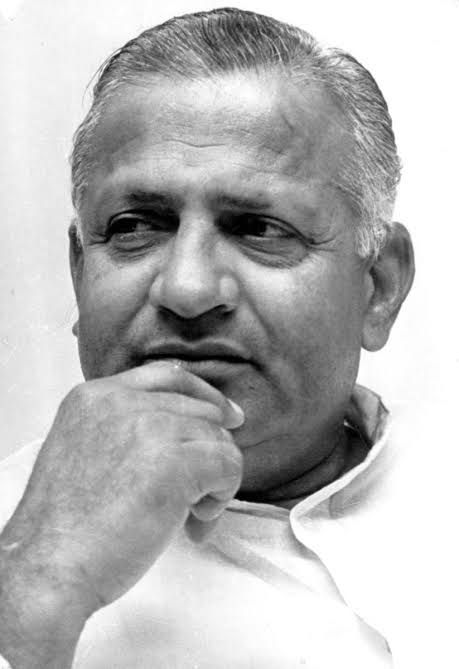
Slide title
Write your caption hereButtonSlide title
Write your caption hereButton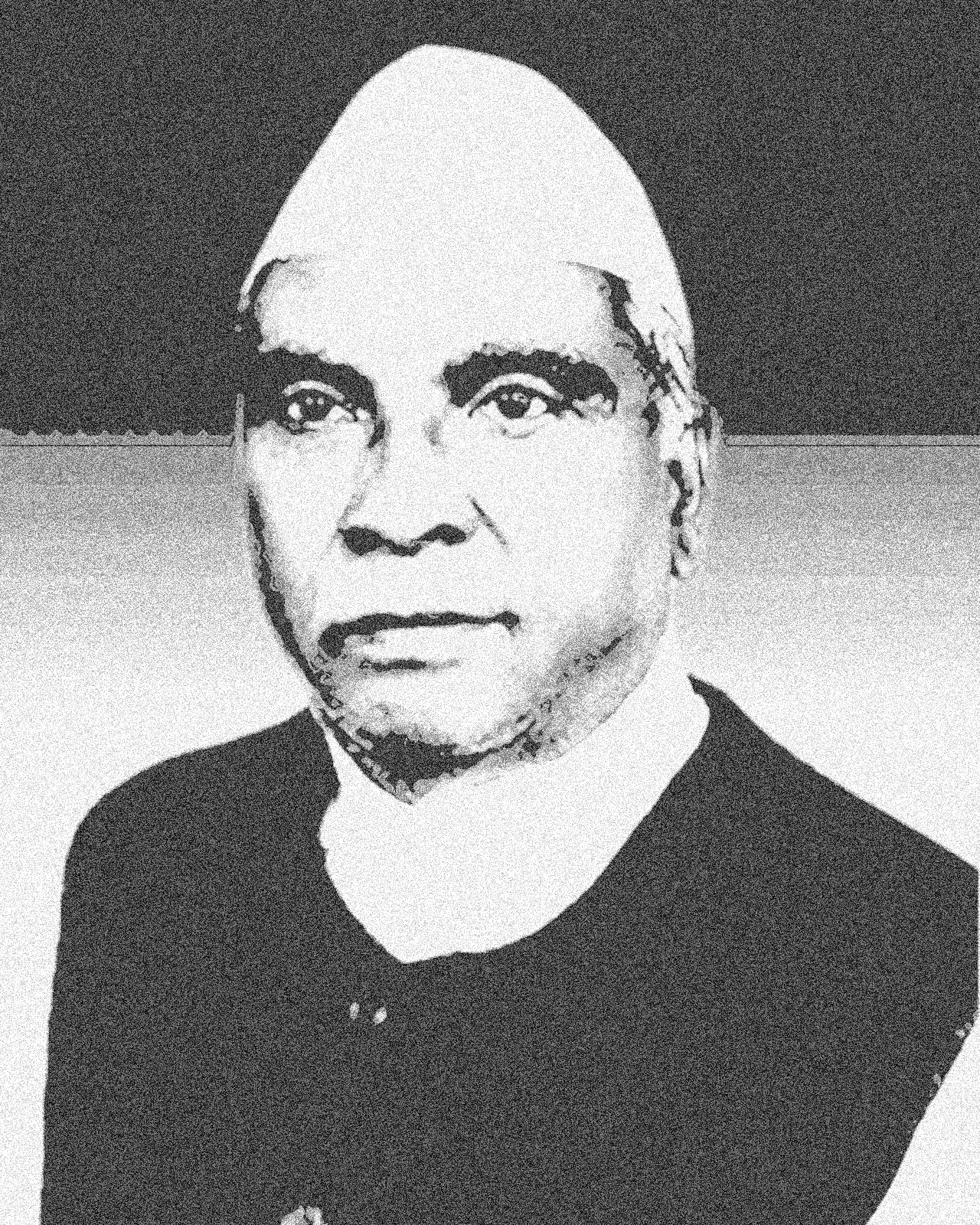
Slide title
Write your caption hereButtonSlide title
Write your caption hereButton
Environmental Support Group (ESG) is an independent organisation that was started in 1996 with solid waste management as a core work area under the Environmental, Social Justice and Governance oriented initiatives that drove the organisation to take shape. ESG’s decades-long documentation aided not only the termination of the landfill but moved the High Court to pass ordinances that organised much of the waste management efforts across the city at the time. Their study included a follow of I.P.D. Salappa’s report from 40 years before, about how little has changed for the Pourakarmika (sanitation workers) of Karnataka, who continue to face discrimination and exploitation.
Notes from ESG’s Report “Bangalore’s Toxic Legacy” produced in 2010
Unplanned urbanisation coupled with unprecedented increase in consumerism are causing extensive impacts on human health and the environment. As urban residents become more consumerist and cities become a locus of intense resource consumption, the capacity to generate waste is maximised. The weak impetus to minimise waste generation and poor management of the waste generated is resulting in a huge public health and environmental problem.
Slide title
Write your caption hereButtonSlide title
Write your caption hereButtonSlide title
Write your caption hereButton
The neglect of such questions result in complex problems that are exacerbated by poor land use planning and waste management practices. There is little or no emphasis on community level solid waste management and this callousness has dire consequences for communities who become victims of large and poorly managed landfills. Forced to coexist with mountains of festering waste dumped in their backyards, these unfortunate people suffer unbearable stench, are forced to drink toxic water and end up with severe debilitating effects on their health and livelihoods.
Over 3000 tonnes of waste is generated in Bangalore every day, a good proportion is unhealthily dumped in the periurban areas of the city, with farmlands and wetlands becoming prime targets. Oftentimes forest areas are also happy dumping grounds for waste disposal. An out of sight out of mind attitude pervades the administration and regulatory approach to solid waste management.
A case in point is what is claimed to be a designated municipal solid waste management landfill at Mavallipura, a village north of Bangalore near Yelahanka. Waste has been dumped here since 2003 in what was claimed to be farmer Bailappa's lands. A consistent process by local people succeeded in stopping this massive illegal waste dump only for a similar landfill to recur abutting grazing pastures extending over 100 acres claimed to be designated scientific landfill managed by M/s Ramky Infrastructure Ltd.
The Mavallipura landfills are a clear indicator of the callous disregard that BBMP has for public health and environmental laws and standards of India. This situation is also an alarming indicator of the appalling dismissal of the Fundamental Right of the communities of Mavallipura and surrounding villages to live a life of dignity, and in a clean environment.
People are dying in Mavallipura today. Despite many falling sick with increasing regularity, there simply has not been any comprehensive effort on the part of BBMP or the health authorities to attend to this health crisis. It is deeply worrying that many are reporting incurable diseases like cancer, kidney failure, etc. which could well be a result of the high toxicity in the ambient environment. This kind of situation arises due to the acute disregard to a simple and effective solution to the problem: segregating waste at source, composting organic waste locally, recovering recyclables locally to the maximum possible extent, and only transporting useless and hazardous material to landfills. For this to happen, everyone who generates waste must own up the responsibility for the adverse impacts we are causing on the people of Mavallipura, and similar communities around Bangalore.
Timeline of events
- Waste Dumping Begins26 May 2003
Bangalore’s waste starts being dumped in what was claimed to be farmer Bailappa's lands post agreement between Bailappa and BMP.
- Declared as eco sensitive zone12 January 2004
Order of the Department of Ecology and Environment declares this area as an ecologically sensitive zone as it forms the watershed of the Arkavathy and Kumudavati rivers.
- Impact Assessment ReportJanuary-March 2004
Environment Impact Assessment Report for the landfill was prepared by M/s Ramky Testing and Consultancy Services erroneously claiming that there are no ecologically sensitive zones within 10 kms. radius
- Setup of Scientific Landfill11 August 2004
A Concession Agreement was concluded between BMP and Ramky Infrastructure Ltd. (RIL) to set up a scientific landfill on the basis of Build-Operate-Transfer (BOT) scheme at Survey No. 8 of Mavallipura village over 100 acres to manage a contracted quantity of 600 tonnes of mixed solid waste per day.
- Civil Aviation refuses NOC14 August 2004
Both defense and civil aviation authorities have (after refusing to grant a No Objection Certificate to Mavallipura landfill in the letter dated 14th August 2004) raised alarm at the heightened risk of air crashes that are likely given the high density of scavenging bird populations such poorly managed dumping grounds attract.
- Scientific Landfill18 August 2004
The Board had authorised the setting up of scientific landfills by BMP at two locations in Bangalore – Mavallipura and Kannahalli.
- Letter to Commissioner of BBMP7th September 2004
Shri. Vittala Murthy, (Secretary to the Karnataka Dept. of Ecology and Environment) in his letter to the Commissioner of BMP stated that “as per Municipal Solid Waste (Management and Handling) Rules, 2000 dated 25.09.2000, the municipal solid waste shall be disposed of in a scientific manner in identified landfill sites only after obtaining authorisation from KSPCB.
- Dumping on a daily basis2003-2006
On a daily basis, 150 to 200 trucks dumped their waste in this land for rent of Rs.12,000/-
- Health Camp ReportsJune 2005
RLHT health camp for local communities reported that a “majority of patients (both children and adults alike) suffered from allergic rhinitis, allergic dermatitis, repeated infections, diarrhoea, sleeplessness, cough and upper respiratory tract infections.
- ComplaintOctober 2005
DSS initiated a formal complaint to the Board.
- Water Contamination22nd October 2005
Bailappa and his family in collusion with BMP officials released thousands of litres of leachates that had accumulated in the dump into the downstream grazing pasture in Survey No. 8. This toxic water soon found its way into wells, streams and lakes, and consequently all drinking water sources were contaminated.
- Encroachment over forest land2005
Landfill in Bailappa’s land closed after discovery of farmer’s encroachment over forest land.
- Legal Action Taken18 February 2006
Karnataka State Pollution Control Board initiated Criminal proceedings against Bailappa and his son by filing a Criminal Complaint before the Metropolitan Magistrate in Bangalore
- Cover Up2006
To cover up the evidence of what lay beneath, the mountains of garbage that had accumulated over the years were burnt off over several days, and tonnes of soil was imported to cover up the toxic mess within.
- Without a Consent29 January 2007
Ramky landfill was made commercially operational without a consent for operation from KSPCB.
- Protest7 October 2009
Riot ensued in Mavallipura when local villagers realised that hundreds of gallons of toxic discharge had been facilitated out of the landfill by digging trenches – so the overflow would not accumulate within the REEL facility, but instead flow downstream into the village.
- Promises9 October 2009
Meeting with the Commissioner, then Shri. Bharat Lal Meena, IAS, who promised comprehensive clean-up, pollution and cattle survey, groundwater contamination, health camps and that fresh borewells would be dug to provide clean drinking water.
- ESG Research beginsNovember 2005 to September 2017
ESG undertook comprehensive analysis of the quality of water in various upstream and downstream locations of the Mavallipura landfills to establish the pollution impact of the illegal landfill developed by Bailappa for BMP between 2003-2006.
- Two DeathsJuly 2010
Two deaths in Mavallipura due to cancer and dengue: alarming indicators of the deteriorating health status of local communities.
- Bangalore’s Toxic LegacyJanuary 1st, 2020
ESG publishes Bangalore’s Toxic Legacy - Investigating Mavallipura's Illegal Landfills.
- Water quality degraded2012
Sufficient information available to suggest that the quality of water in Mavallipura and downstream villages has degraded rapidly.
- Landfill ShutdownJuly 2012
Ramky landfill closed after action initiated by KSPCM after several protests and demonstrations by the community.
- Bangalore’s Toxic Legacy IntensifiesFebruary 2018
ESG publishes Bangalore’s Toxic Legacy Intensifies - Status of Landfills, Waste Processing Sites and Dumping grounds, and working conditions of Pourakarmikas
In under 10 years,
the city of Bangalore dumped about
675250 truckloads of waste in Mavallipura’s landfills, amounting to about 10,22,000 tonnes.
For perspective, those many trucks, if queued up one behind the other, can cover the north-south length of India 2.5 times - that’s Kashmir to Kanyakumari to Kashmir and back to Bangalore!
The waste at Mavallipura corresponds to about 50 UB towers by volume!
Imagined as a wall, this waste can enclose the entire city of Bangalore above the height of the UB tower (123 m)!
As a 6 foot high wall this volume of waste can surround the entire coastline of India’s mainland!


